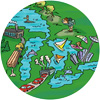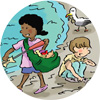|
|
Background – Weather in Schools |
People often confuse weather and climate. Weather is hourly or daily atmospheric phenomena, such as temperature, precipitation and wind, while climate refers to the weather conditions for a given area over several years. Weather is a big part of our Canadian identity and we have learned to adapt to the variety of weather conditions that come with the different seasons of the year. Meteorologists study the movements and conditions in the atmosphere that produce our weather to forecast what we should expect from the weather on any given day. Snow days are one example.
There are many natural processes and factors in the atmosphere that shape our weather – things that can be studied in atmospheric sciences. As well, more and more pollutants and pollutant sources are influencing the weather we experience day to day. Smog alerts, ultraviolet radiation exposure alerts called the UV Index forecast, wind chill and humidex temperatures are now a common part of our weather forecasts.
The earth’s ozone layer is not as thick as it used to be and more and more ultraviolet (UV) radiation from the sun is reaching us. Exposure to UV rays from the sun increases the risk of sun burns, skin cancer, cataracts and can weaken the immune system. The daily UV Index forecast – a simple numerical scale forecasting the maximum UV for the day – is a guide for people to take appropriate precautions to protect themselves from overexposure to the sun.
Smog is a harmful mixture of many air pollutants that affects the quality of the air we breathe and often appears as a brownish-yellow haze. Smog is mainly a concern in large towns and cities during hot weather because of the number of motor vehicles, but smog travels with the wind so it is also a problem in other places as well. Poor air quality from smog affects the health of people and animals; children tend to be more sensitive than adults because they breathe faster and typically spend more time outdoors. That’s why smog alerts are an important part of weather forecasting.
Anyone who has gone out for recess on a cold and windy winter day knows that you feel colder when the wind blows. Wind makes your skin lose heat faster than it would on a calm day in the winter. The cooling sensation caused by the combined effect of temperature and wind is called wind chill and it is talked about the same way temperature. It’s important to listen to local weather for wind chill temperatures because they will be much closer to what you actually feel when you are outside on a winter day. The same goes for the summer when humidity, water in the air, makes it feel hotter; humidex readings tell you what it will actually feel like when you’re outside.
|
Where is weather important at school?
|
School Grounds: wind chill, ultraviolet rays, air quality, humidex
Parking Lot: idling cars and buses
 |
Taking action at school |
It’s easy, fun and important to watch and understand the different aspects of weather at school so that outdoor activities can be enjoyed safely and that precautions, like indoor recess, can be taken when necessary.
Some ideas for watching the weather and enjoying the outdoors safely:
- Register your school to be Sun Savvy and learn about sun awareness and the UV Index (see Children’s UV Index Sun Awareness Program www.msc-smc.ec.gc.ca/uvindex)
- Check your local weather forecast every day and discuss what it means.
- Promote “no idling” in parking areas. In winter, idling is sometimes unavoidable, but drivers can be encouraged to reduce vehicle idling (and waiting) by arriving on time rather than ahead of time.
- Educate drivers – teachers and parents, to avoid using remote car starters, because they encourage people to start their cars before they are ready to drive, increasing unnecessary idling.
- Landscaping and natural areas in a school yard, such as berms and trees, can provide protection from wind and sun.
Helpful Weather Web Sites:
Welcome to the UV Index home. Information and links on the science of the ozone layer, ozone depletion and sun protection. Find out about the Children’s UV Index Sun Awareness Program and register to be a Sun Savvy School Club.
www.msc-smc.ec.gc.ca/education/teachers_guides/
Project Atmosphere Canada offers information to encourage the teaching of atmospheric sciences and related topics and to promote an interest in meteorology among young people (Grades K –12).
www.weatheroffice.pyr.ec.gc.ca/skywatchers/index_e.html
Find out more about Environment Canada’s Sky Watchers program.
www.pnr-rpn.ec.gc.ca/air/wintersevere/weatherwords.en.html
Click on to this Just for Kids site that includes Weather Words and Winter Activities.
|
Ideas for Great Acts
|
Why not let Mother Nature help teach weather to your class. Join Environment Canada’s Sky Watchers program. (www.weatheroffice.pyr.ec.gc.ca/skywatchers/index_e.html)
Start a school weather forecasting club and make weather a great part of everyone's day at school. Include students, teachers, parents, etc. and provide a daily weather forecast (with explanations) during daily announcements.
 |
Games and Activities |
www.weatheroffice.pyr.ec.gc.ca/skywatchers/kidsStuff_e.html
Have fun with quizzes and challenges and visit a virtual weather office.
www.on.ec.gc.ca/greatlakeskids/glk-video-e.html
How a Weather Forecast is Made -- this eight-minute video explains every aspect of producing weather forecasts and severe weather warnings.
 |
Students Leading the Way -- Tell us what you’re doing to put weather front and centre at your school. |
 |





